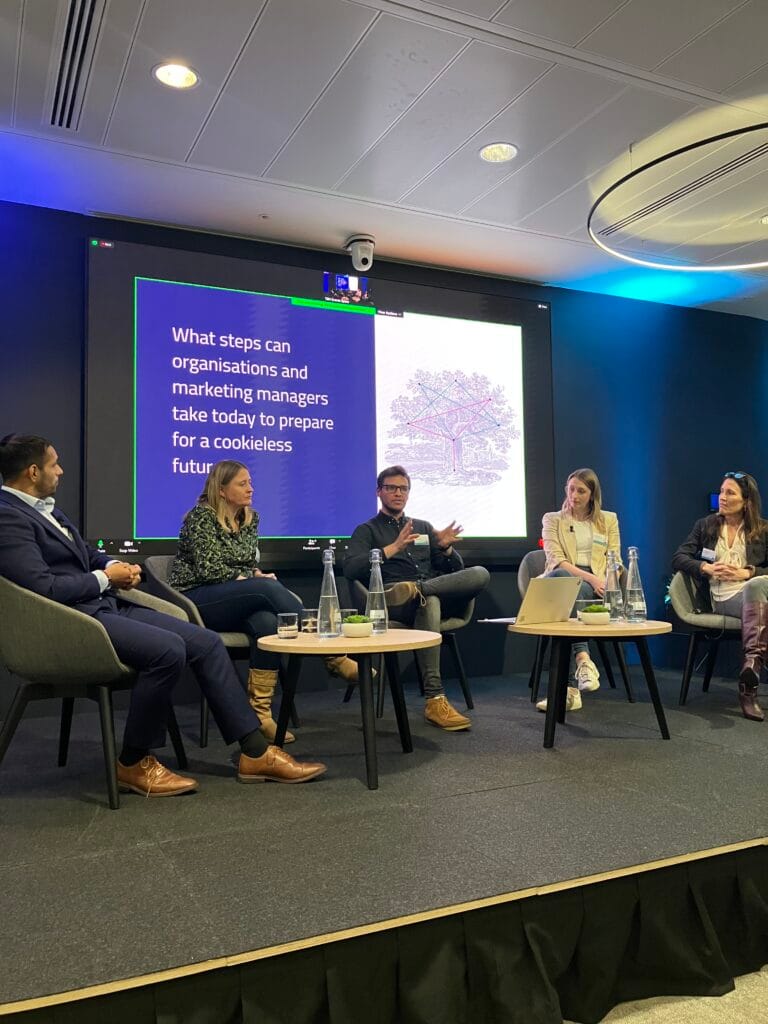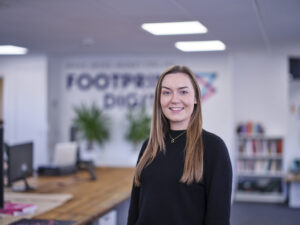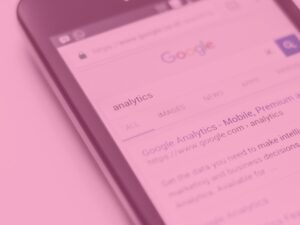
Blog
Data in a Cookieless World: What Positives can we Draw from Changes to Data Laws and Privacy?
30th Oct, 2023
In October, we hosted an event in partnership with law firm, RPC, looking at how marketers will be able to use data in a cookieless world.

Our panel consisted of five industry experts – Kiran Dhoot, Associate at RPC; Sarah Edwards, Director at Make it Clear; Sarah Willcocks, CEO at Screen Pages; Kate Brinkley, Head of Digital Planning at The Specialist Works; and Tom Cox, Relationship Manager at Footprint Digital.
The third question put to the panel looked at whether a cookieless world could be a positive thing for digital marketing managers…
Kate: One thing that’s come to light from my side of things is a real fresh look at measurement. How are we judging the performance of marketing and advertising as a whole, what are we judging it against and do those metrics actually matter to the business? When everything was trackable, we almost got to a point as marketers where we optimised ourselves into 101 online KPIs that didn’t really matter in terms of delivering actual business growth.
What this has done is put a focus on understanding what we’re measuring, why, and how. We’re starting to relate the measurements that we’re looking at back to business success because it needs to be a little bit more holistic from a whole media and planning framework. We were also maybe existing under the impression that that framework was always a perfect measurement system – and it never was.
That measurement has never been perfect. It’s only ever shown you an angle of the picture, so what we’re now having a much broader discussion with our clients about, is what are the different elements that feed your business success? What are the different ways we can look at that, on a holistic level, to understand what’s driving change for your business?
From my side – it’s enabled us to lift our heads out of some of the real details of digital performance channels, and look more holistically at what’s driving the business, how are consumers interacting with it, and are we actually influencing that behaviour? Bigger picture thinking has been a massive positive and has gotten that measurement agenda further up clients’ agendas, as well as more senior client agendas which is really valuable.
Tom C: From a marketing manager perspective, it’s been quite a nice thing to look at with our clients. As marketers, we sometimes get too carried away with the hype around super-targeted campaigns. We like to focus a lot on that 1% of the audience and once we’ve found that audience we really nail down those tiny segments, but I feel like we’re missing the bigger picture from that. As much as we’re targeting the 1%, there’s still that 99% available.
There’s a sense of over-targeting individuals and we lose that opportunity for the bigger picture. There’s going to be more of an opportunity to focus on brand building, looking at customer funnels, and one of the analogies I’ve seen is: if you group people into targeted, granular demographics and you have someone who was born in 1948, in England, they live in a castle, very wealthy, they’ve been married twice – so is that King Charles or Prince of darkness Ozzy Osbourne – they both fit into that very granular category.
Kate: What’s interesting about that is it’s getting away from data and remembering that whatever we’re doing, we’re talking to people. Actual people. Cookies enabled us to have so much data, more data than anyone could remember. I think it was easy to fall into the trap of looking at the data and forgetting the people and the personal perspective on that and what’s impacting them.
Bringing it from a planning perspective, we want to think about how people interact with different media channels, and therefore how can I target based on contextual data, based on time, based on their browsing activity etc. I’m still really adding value, but I’m thinking about what mindset you’re in as a person – not in a deep deep hole of data trends that have lost that personal feel.
Kiran: The concept of excessive data points is really key. Some of us may have read GDPR and Article 5; data minimisation is a really important principle, the less data you hold the less risk you have. Marketers who have reams of data – imagine if you never had it in the first place, but you’re still able to be innovative, you’re able to do more with less. It’s a win-win from a privacy and a strategic perspective, so it’s a massive opportunity in this area to start thinking about what the best data points are, rather than the volume of data points.
Tom C: It’s going to tap into a lot more creativity as well and I think a big change is going to be that it’s not going to be so focused on narrowing down and over-granulation, and more so focusing on a wider stretch of people. Brand building is going to be much more important, but I think that marketing should follow that whole sales journey as well.
That whole thing around awareness consideration conversion – it’s no different to how people utilise that data, so I think that’s going to be a big focus point going forwards. Even more so around identity data providing a makeup of an audience that we want to target.
Sarah W: We started building shopping websites [at Screen Pages] before there was all this third-party data, Google Analytics stuff. Your customers or visitors to your website are going to tell you everything you need to know about what you should be doing. Back in the day, people would send out surveys or do questionnaires.
We’d look at first-party data and what individual customers said they wanted. The good news is that technology has moved on, so you can give people a personalised experience based on their individual preferences and that can all be automated – but if you have a certain number of registered users on your website, you should be collecting data from them. And that should be driving your decisions about what products and services you offer.
Sarah E: As a UX agency, that’s really what we advocate too – talking to your users, user profiling, actually getting in front of them and talking to them. Picking up the phone, doing some focus groups, and actually understanding what they want. That angle and the contextual element mean that you’re then creating better user experiences and better content. That’s a real positive from this.
Kiran: When we talk about the progression of technology, obviously we’re still in that progression and there’s much more to come. One thing we can take comfort in is that the regulators are on board. So, the ICO for example, has launched a sandbox.
They love to see people come up with new innovative ideas, for example, let’s just pretend cookieless really meant cookieless – what sort of technologies need to take their place? They need to be tested somewhere.
The ICO has a focus on this area. Some people may have seen it’s issued regulatory statements recently about cracking down on cookie banners, telling people to make sure that you’ve got ‘reject all’ in the first layer etc.
But they’re also making sure that new technologies have a place where they can be developed and tested, and the ICO can then help them become privacy compliant, and then suddenly that tech becomes available to us, and we can look at it and know it has some backing behind it.
So, it’s not that the regulators are there to just stop us, they’re also trying to give us tools to really amp this up.
Kate: I think that the development of technology is where things get really interesting. We’ve been so focused for the last six/seven years on what cookie signals can drive, but actually, there have been lots of things that have fallen by the wayside as part of that. There’s been lots of talk in the last 18 months or so about the attention economy.
There’s a huge amount of value in understanding exactly how people are interacting with a website, therefore are they seeing your advertising, and is it having an impact on their behaviour?
The nice thing about the attention economy is that it levels down the line. Rather than ending up with so many ads on pages that you can barely read the content anymore, we could actually get to a point (with a lot of buy-in) where we see attention as ‘less is more’.
We could start to look at less ad load on pages, we’re looking at better user experience for people using the internet, people are in a more positive mindset, it’s then easier to advertise to them. There’s also a definite sustainability angle.
There are big bits of technology that are driving really interesting change because we’ve gone slightly away from the big data AI processing massive behaviours at scale, to actually understanding a little bit more about how people are engaging with media.
Tom C: It’s almost about taking marketing back to basics, and not being so reliant on all of that data. There are lots more avenues and opportunities we can take.




